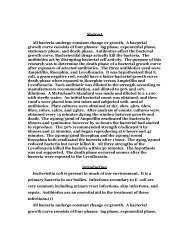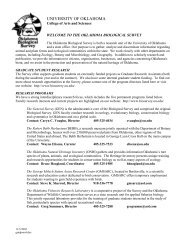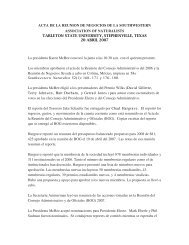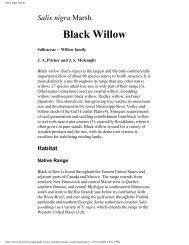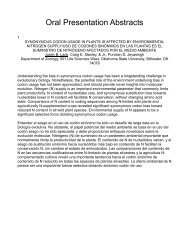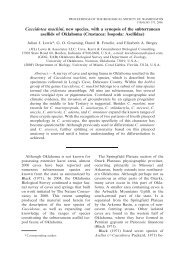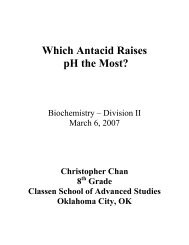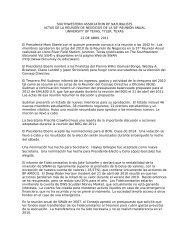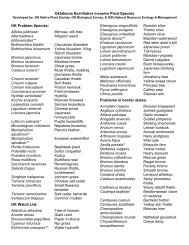Mary Masterman - Oklahoma Biological Survey - University of ...
Mary Masterman - Oklahoma Biological Survey - University of ...
Mary Masterman - Oklahoma Biological Survey - University of ...
You also want an ePaper? Increase the reach of your titles
YUMPU automatically turns print PDFs into web optimized ePapers that Google loves.
Discussion <strong>of</strong> Results<br />
9<br />
Eventually, both the Raman head and the Littrow spectrograph were successfully constructed and attached. Raman spectra <strong>of</strong><br />
various substances, including standard Raman chemicals like acetone and toluene and also other various materials, including ethyl<br />
alcohol, glass, diamond, acetaminophen (Tylenol), and Teflon, were successfully observed. With many materials, fluorescence was<br />
a problem, probably due to the relatively high frequency (as compared to infrared) <strong>of</strong> the laser. Spectra were calibrated with a<br />
mercury lamp, and the observed wavenumbers for various lines in the spectra correlated very well with published wavenumbers.<br />
The resolution <strong>of</strong> the Littrow spectrograph with the 1200 lines/mm grating was about 7000, and the range was about 300<br />
Angstroms, which turned out to be enough to cover most <strong>of</strong> the desired spectral range with Raman. It did prove to be a challenge to<br />
maximize the intensity <strong>of</strong> the Raman signal, especially with the higher resolution spectrograph and the very thin slit required <strong>of</strong> the<br />
higher resolution setup; but when exposure lengths were adjusted, spectra could still be successfully obtained <strong>of</strong> molecules with<br />
pronounced Raman resonances.<br />
After the Raman spectrograph system was completed, the main obstacle to good spectra proved to be an unexpected one: all <strong>of</strong><br />
the Raman lines, as it became apparent as I narrowed my slit and got higher resolution spectra, did not have sharp, well-defined<br />
pr<strong>of</strong>iles as described in the literature but instead were complex blends <strong>of</strong> three or four peaks. At first I attributed this to some flaw <strong>of</strong><br />
the Littrow spectrograph, which was actually producing lines with a slight ghost on the red side (perhaps because <strong>of</strong> the highergroves<br />
per mm diffraction grating). I noticed, however, that the laser line in particular was characterized by the complex pr<strong>of</strong>ile, and<br />
the mercury lamp calibration lines were not. When I took spectra <strong>of</strong> the laser line by itself, without any filters, I saw that it was not<br />
outputting light at one specific frequency, but rather at several, and that—since Raman frequencies are independent <strong>of</strong> the laser<br />
frequency—the Raman lines were mimicking the same spectral pr<strong>of</strong>ile. To produce better quality Raman spectra, I would need a<br />
more expensive single-mode laser.<br />
Since a laser line was visible in most <strong>of</strong> the spectra obtained, I wondered what the attenuation <strong>of</strong> the laser line by the barrier filter<br />
was. It was found the ratio <strong>of</strong> the laser line intensity to the intensity <strong>of</strong> the blocked laser was 1.25 * 10 5 , with a 3.5% error (over two<br />
trials). When the intensity <strong>of</strong> the Raman signal for toluene, an enthusiastic Raman scatterer, was compared to the computed,<br />
normalized full-intensity laser beam, it was found that the ratio between the intensities <strong>of</strong> the Raman Stokes scattering and the laser<br />
line was 3.7 * 10 -6 . This was comparable to the 10 -6 or 10 -7 value mentioned in the literature.



